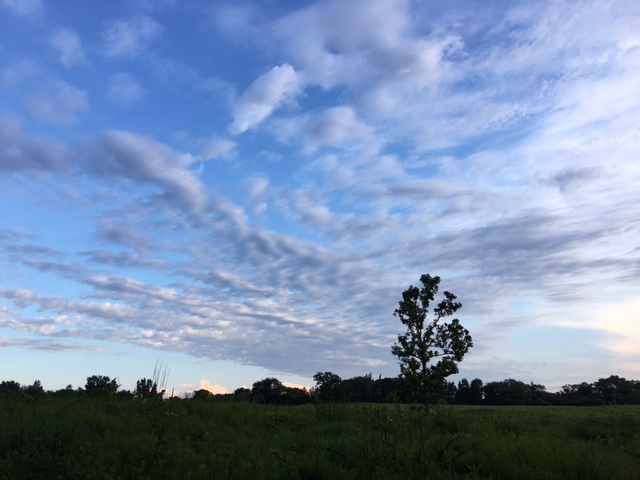
Gardeners have a different perspective on the weather than most people. We are cheered by July downpours and winter storms that spread insulating snow. We love cool, wet springs that lengthen bloom time, while other people are anxiously waiting for the year’s first shorts-and-T-shirt day. Stretches of hot summer days may delight children and beachgoers, but they make gardeners fret about watering. We follow the weather report like some people follow the World Cup.
I like knowing that my garden is mostly at the mercy of the weather. It makes me pay attention to the big picture of nature. I learn about the interrelationships between the plants and animals in my yard—for example, how different weather favors different weeds. Depending on the weather requires me to study my garden, to think through how the soil and the plants are likely to change in different conditions, and it keeps me connected to my place.
How do I study the weather of my place? Fortunately, today there is an abundance of online sources for big-picture and tight-focus weather information. Here are a few I find useful.
Plant hardiness zone maps: Knowing your USDA hardiness zone is basic to American gardening. Areas with lower zone numbers have colder winters, requiring plants that are more hardy. This is essential information for reading plant labels. The current (2012) map reflects the increasing effects of climate change and more sophisticated mathematics. On the website, you can search it at the level of your zip code. The map doesn’t tell you everything about your climate; it only addresses winter, and some kinds of weather and some geographical features introduce complications. The American Horticultural Society has a good discussion of these factors. Its page also includes AHS Heat Zone Map, which is intended to address the effects on plants of blazing hot summers as well as cold winters. In the past, heat zones have mattered most in the South and West, but I expect they will matter more in the Midwest as the climate continues to change.
More zone insights: A number of sites show maps extending the USDA hardiness zones to the United Kingdom and Europe. They’re dated, based on the old (1990) USDA map data, but still instructive. For Midwestern gardeners, the big lesson is that the gorgeous British and French gardens we admire in books and TV shows are in places with much milder winters. London and Paris are in Zone 8—like Louisiana—and even the blustery highlands of Scotland are only Zone 7, like southern Tennessee. So it’s not a good idea to be an English garden copycat in Minneapolis (Zone 4).
Current weather: Weather Underground is a clear, easy-to-use site for checking current conditions; you can narrow it down to the zip code. The best part, for me, is the Historical Weather page (“historical” means yesterday and on back). This lets me check what’s actually happened over the last week or 30 days. It’s a useful corrective: We often have a dim general sense that there’s been a lot of rain, when in fact that was three weeks ago. Spending workdays indoors in air conditioning can make us underestimate how many really hot days we’ve had. I’m also a devotee of CoCoRaHS (sounds like hiccups). The Community Collaborative Rain, Hail & Snow Network has volunteers all over the country checking rain gauges in their backyards and reporting the results daily. There are volunteers in my neighborhood, so I get precipitation data from practically in my backyard. One reason that matters is that TV weather reports can distort our perceptions. I often see TV crews breathlessly reporting on a major downpour that happened at the other end of the Chicago metropolitan area, when the storm missed my yard by 20 miles and I didn’t get a drop. A gardener should always bring critical thinking and local knowledge to bear on TV weather reports.
Planting dates: Due to the influence of large bodies of water (like Lake Michigan, for the Chicago area), mountain ranges, and other geography, climate can vary quite a bit in a metropolitan area (or TV market). For example, there’s more than a month’s difference in the length of the growing season in different areas around Chicago. Plantmaps is a useful way to get local guidance. Plug in your zip code and it will show local average first and last frost dates and other useful climate information.
Drought monitoring: NOAA maintains a Drought Monitor map page that is aimed at farmers, but it can be useful information for gardeners in dry weather.
State conditions: This is pretty geeky, but I sometimes consult the Illinois climate data web page of the Illinois State Climatologist and the Illinois State Water Survey. It’s not terribly local—it reports data by regions that include several counties—but the maps give me a good idea of overall trends. Most states have something similar.
Of course, the data that come from my own yard are as critical as the information I can get online. In the summer, I stick a finger in the potting mix of several containers every day to see if they need watering. I watch out for plants that are wilting. Every few days I dig in the beds with a trowel to see how much moisture there in the soil—and I vary my spots, since trees, building and fences can block rain in some places. In early fall, I watch for the first color in the trees, a sign they’re going dormant. As winter comes, I tread on my soil to see if it’s frozen yet. After a snowstorm, I look to see how deeply the snow piled on the much snow piled up on the birdbath. In late winter, I watch the shrubs to see if their buds are swelling yet. My garden is where the weather matters.


